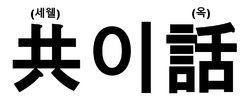Severiók: Difference between revisions
No edit summary |
|||
| Line 62: | Line 62: | ||
===Children's script=== | ===Children's script=== | ||
The Children's script (-) is the system of transliterating the Scholarly symbols into the Spoken script. It is most commonly used in study materials and in conjunction with rare Scholarly symbols to help the reader to better understand text. | The Children's script (-) is the system of transliterating the Scholarly symbols into the Spoken script. It is most commonly used in study materials and in conjunction with rare Scholarly symbols to help the reader to better understand text. However, the system is rarely used in the media and is rarely used by the government in any official context. | ||
==Vocabulary== | ==Vocabulary== | ||
==Words== | ==Words== | ||
Revision as of 08:55, 25 May 2019
| Severiók | |
|---|---|
| Standard Aprosian | |
| |
 "Severiók" in the Severiók language. | |
| Native to | Aprosia |
Native speakers | Over 1 million (2008) L2 speakers: 97% of Aprosian population |
Aprosiatic/Turkic (?)
| |
Early form | Múzan language
|
| Aprosiatic writing system | |
| Official status | |
Official language in | Template:Country data Aprosia (as Severiók) |
| Regulated by | National Committee of the Aprosian languages |
| Language codes | |
| ISO 639-3 | – |
Severiók, also known by its translated name Common Speech or Standard Aprosian, is the official federal language of Aprosia. It is the standardized and revived register of the Múzan language, used as the lingua franca and the language of religion by the multilingual Aprosian Empire. It continues the Múzan language's tradition as the national lingua franca and as the unifying language between the different ethnic groups of Aprosia.
Most Aprosians are fluent in one of the 4 regional official languages, most formal education, and nearly all national mass media, governance, administration, judiciary, and other forms of communication, are conducted in Severiók, leading to most Aprosians being capable of speaking the language fluently. It is also one of the mandatory languages in education in Aprosia, being taught from elementary school all the way to the higher education.
The language's native name Severiók is the usual translation for the language in many regional languages, with the language sometimes refered to as Common Speech or Standard Aprosian in the fields of linguistics, due to the language's position and the translation of the language's name.
History
Official status
Phonology
Grammar
Writing system
Severiók, like all of the modern Aprosian languages, is written in the Aprosian script, that originally came from the writing system used by it's neighbours, especially in Tuthina. Under the rule of Džéhar Náj, colloquially known as the Royal Writer, the Empire sent an embassy to travel through its neighbours. (CONTINUE)
The Aprosian writing system is divided into three parts; the Scholar script (學者니文, Zádunímen) used for primary words and meanings, the Spoken script (話헤文, Ókšémen) used for agglutination and colloquially to write the language and the Children's Script (-) written next or above the Scholar script charecters to show the charecter's pronounciation.
Scholar script
The Scholar script (學者니文, Zádunímen) is a logographic system of writing, used as the main component of writing in the Aprosian writing system and as such, in all of the Aprosian languages. The Scholar script is used to write most content words in the language and the symbols purely display meaning; the pronounciations of the charecter vary in different contexts and must be memorized to read a text outloud. Due to the charecters largely retaining their historical meaning however, it is possible for a non-speaker to read the Scholar script and understand most of the text's meaning, while not being able to speak or pronounce the words.
The estimated size of the Scholar script varies by definition, but it is estimated that the Aprosian languages include over 20,000 charecters, both currently used and archaic, but due to the amount of compound words in the Aprosian languages formed using different charecters of the Scholar script, the system is very flexible and new meanings can be created using 2 or more charecters. The education system in Aprosia has a set of 3,100 charecters, known as the Common Script (共이文, Severímen) necessary for an Aprosian student to learn to understand the majority of the Aprosian writing system. A well educated person however, can learn an average of 6,000 charecters during his life.
Spoken script
Unlike the logographic Scholar script, the Spoken script (話헤文, Ókšémen) is a featural alphabet, used by the Aprosian to write different the grammatical parts of the Aprosian languages that do not have a symbol in the Scholar script. It is also used in transliteration, writing loan words without Scholarly symbols and for general writing in colloquial situations. Due to the relative easiness of learning the Spoken script, it the first system of writing tought to Aprosian children and foreign students. The Spoken script has a total of 19 initials, 21 vowels and 28 finals, which can be combined into a total of 11,172 compound symbols, although as the system was imported from neighbouring countries and from very different languages, the exact amount of used compound symbols in the Aprosian languages is not clear.
Children's script
The Children's script (-) is the system of transliterating the Scholarly symbols into the Spoken script. It is most commonly used in study materials and in conjunction with rare Scholarly symbols to help the reader to better understand text. However, the system is rarely used in the media and is rarely used by the government in any official context.

